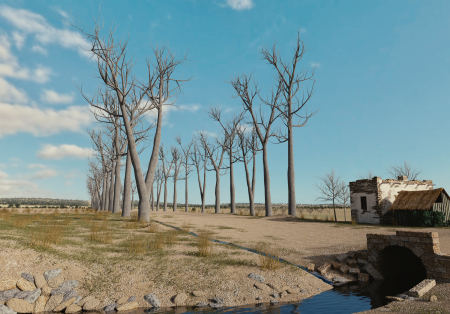The Alameda was an area along the road to the Powder House (now East Commerce Street) between the Madre and Alamo acequias. The road was wide and flanked by cottonwood trees that were planted in the early 1800s. Alameda is a Spanish word for poplar grove. This was the staging area for the Mexican cavalry on the day of the battle where they waited for the defenders to flee the fort in the face of the main attack from the north. The place is also significant in that Santa Anna ordered the bodies of the defenders to be burned on two pyres a few yards on opposite sides of the boulevard.
While the exact location of these pyres has been lost in the sands of time, the San Antonio Express (March 26, 1911) published recollections of people who knew the place in an earlier time. I liked this description:
There was an orchard very near the place where the bodies were burned on the south side of the Alameda, and it is stated that flames and sparks blowing in the fierce March wind that prevailed a part of the time during the incineration blew the flames into the orchard injuring many and destroying some of the fruit trees, most of which died soon after. This fact probably gave rise to the prevalent belief that obtained for many years, that after the bodies were burned none of the fruit trees in the neighborhood would bear and that they as well as the cottonwood trees all died soon after. It is a fact that there are now no bearing fruit trees within a block of where either of the two pyres were, and there are but two of the fifty or more cottonwood trees left that grew originally on the Alameda. Neither of them is within a block of either of the pyres.
For many years the Alameda was at the eastern extremity of San Antonio. It extended from where St. Joseph’s Church is now to about a block east of Water Street, or at least the double row of cottonwood trees did. All east of there for some distance and, in fact, as far as the Salado was devoid of trees of any size. The Alameda was about the width of the present Alamo Plaza and about twice as long. It was traversed by three irrigation ditches, each of which furnished moisture for the cottonwood and other trees about it. Flowers also grew there in profusion. It was a beauty spot of the town for many years and was a favorite _____ or pleasure place of the populace, where music either by military or other bands played while the people promenaded. As is the custom today in Mexico, the women and girls walked in one direction, while the men and youths paraded in the opposite, and passing each other instead of promenading together.
Many deadly duels were fought on the Alameda between rival lovers and others who could only appease their anger by shedding the blood of their adversaries. Most of the duels were fought between Mexicans and they almost invariably contended with knives. Some of the duelists used pistols. In the days of dueling the pistols used were those that had single chambers and fired but single charges. They were muzzle-loading weapons and the earliest used had flintlocks.
Reference Images
The Alameda was painted by Texas landscape artist Hermann Lungkwitz in the 1850s. I used a black and white photograph and a color rendering of his work as my references.
The Scene
My goal was to project the Lungkwitz view of the Alameda back to February 1836. I attempted to match the aspect ratio of the drawing and artist’s location and field of view. The post 1836 structures were removed. The number of cottonwoods were restored to extend between the acequias and the foliage removed to reflect the time of year. I decided to match the culvert in detail including erosion damage even though it probably looked differently in 1836.
The Techniques
This project was a good study in that it required learning many techniques that will be useful in creating detailed renderings of other locations in my model.
- The land contours of the foreground were created using Blender sculpting tool. The background was from my base model.
- A water material was customized to produce the appropriate reflection, refraction and ripple effect.
- The foreground “hero” trees and bushes were created using the Sapling add-on in Blender. I edited the result to give the trees a more natural shape. Background trees were created with 2D textures from Xfrog applied to planes used as billboards.
- The background trees were applied using Blender’s particle system.
- Two types of grass were modeled and applied with particles. Weight painting was used to control the density and placement.
- The culvert was modeled in Blender block-by-block to match the pattern in the reference and to increase the realism over a simple applied texture with displacement map.
- The texture on the stone house was created to closely match the pattern of wear of the plaster as seen in the reference.
- A slight mist effect was added to the background hills to enhance the sense of distance.
- The lighting and sky was done using an HDRI sky map from Hyperfocal Design (a very good product). The sun position was adjusted to approximate the time of day in the reference images.


